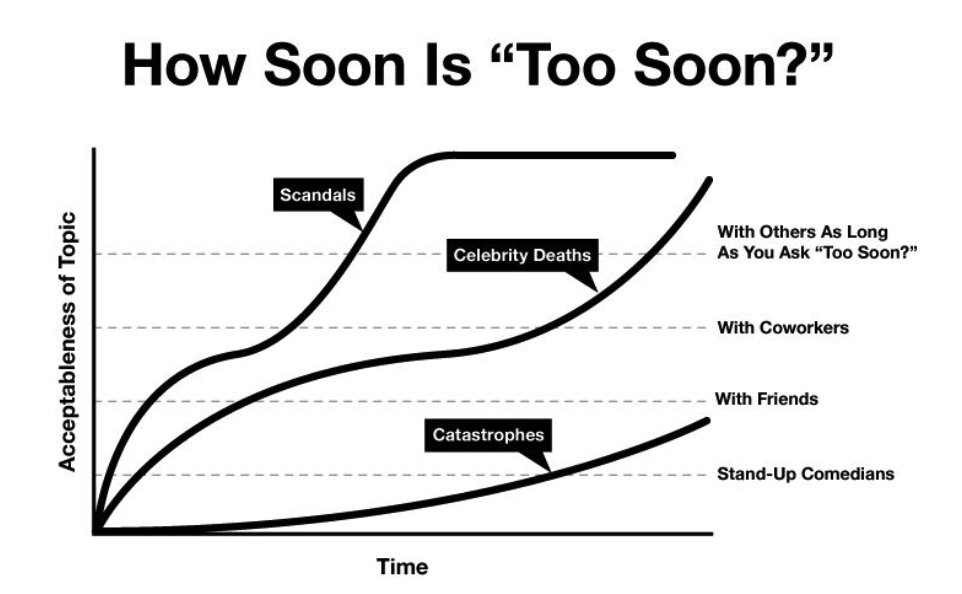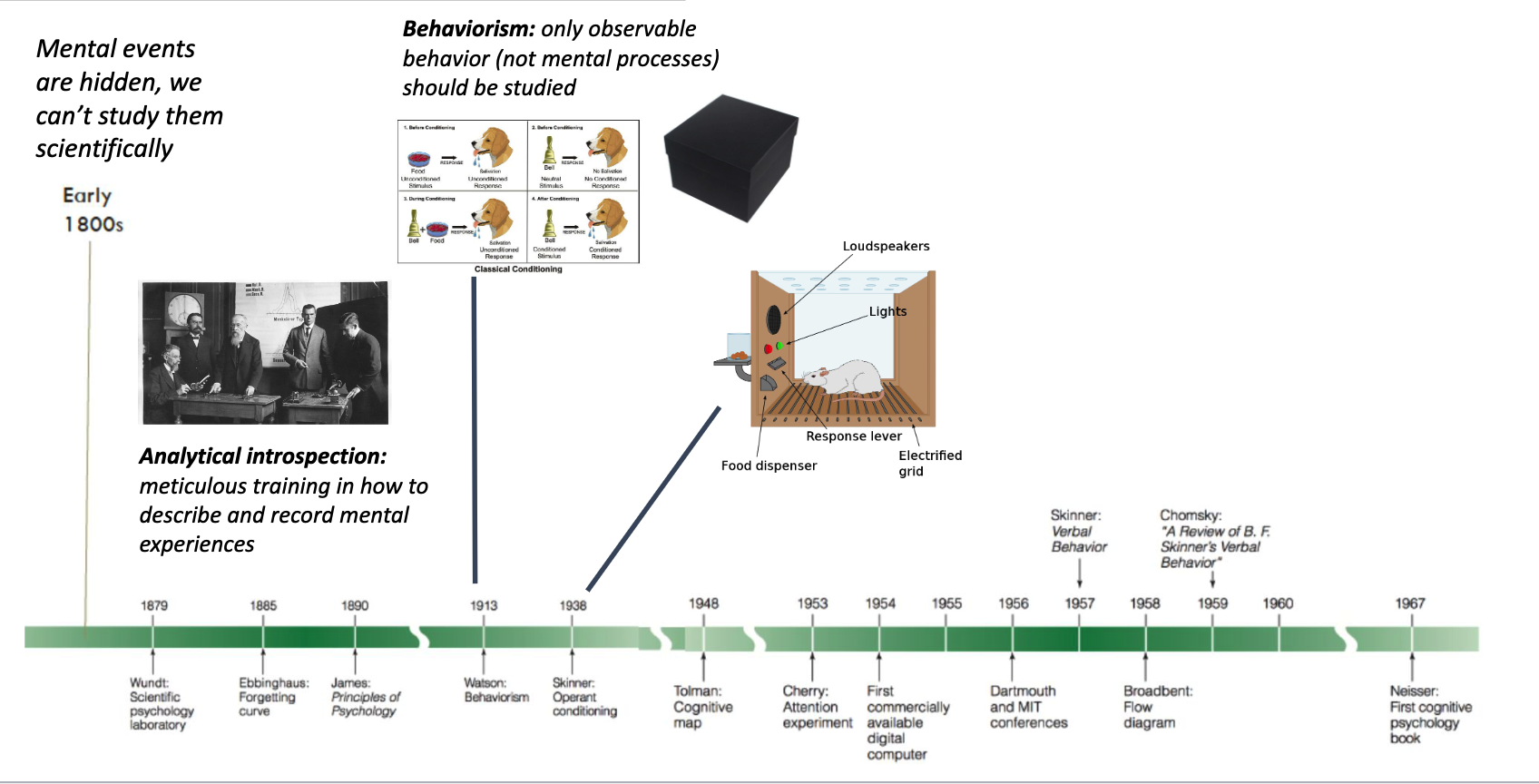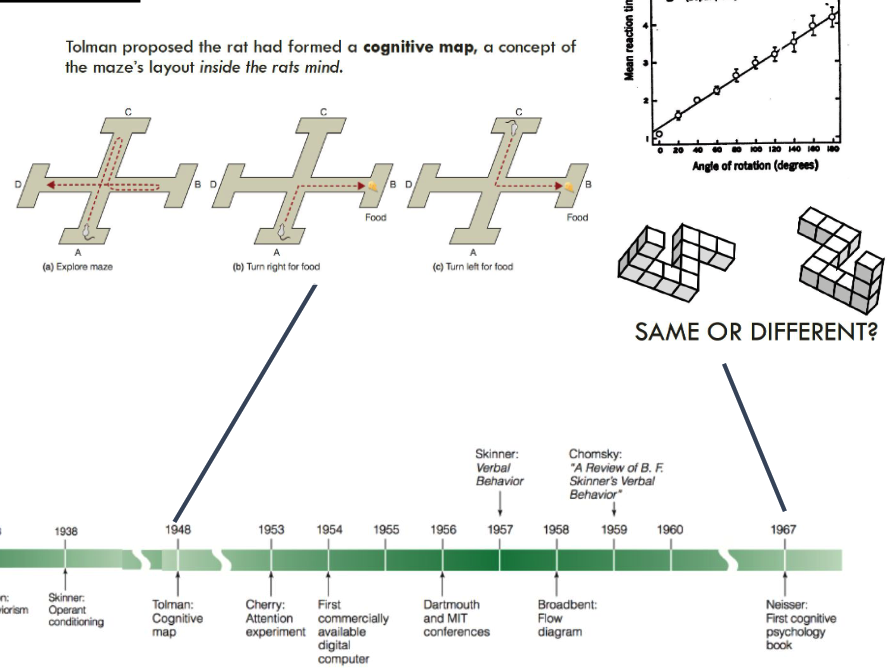Week 4
Benign Violation Theory
Humor arises when something is perceived as simultaneously threatening (a violation) while still being perceived as harmless or OK (benign)
Violations (threatening, negative, wrong)
Physical threat
Threat to dignity
Norm violation
Benign (safe, acceptable, okay)
Play fight
Teasing
Norm unimportant to you or is psychologically distance

A violation is made benign if there is a psychological distance from the violation
Spatial (how close that you’re to the event)
Social (the kind of people)
Temporal (the time)
Hypothetical (how likely has this event actually happened)
Manipulated psychological distance
Increases the funniness of highly threatening (here imagined) events by making them seem more benign; decreases funniness off events already low on threat

Cognitive Approach
Humor and memory
Incongruity-resolution
Using lexical decision tasks to investigate schema activation in humor
Modeling incongruity as semantic distance
System 1 and 2 Thinking
Humor as a cognitive ability
Insight, creativity, divergent thinking
Background
Cognitive psychology
is the study of mind and mental function. including learning, memory attention, perception, reasoning, language, conceptual development, and decision-making, resting on the premise that the brain can be understood as a complex computing system
Mental events are hidden, we can’t actually study them scientifically


Mental representation
How is knowledge about the external world represented and manipulated to accomplish perception, memory, problem-solving, etc.
Conceptualized in various ways, such as mental images, concepts, abstract symbols, or embodied representations
Cognitive Models of Memory
Selective attention allows us to focuses on a particular stimulus while simultaneously ignoring other stimuli in the environment
It enables efficient information processing by prioritizing relevant information and filtering out distractions
In a dichotic listening task participants successfully shadow an attended message, but encode almost nothing about the unattended channel
We “pay” attention because there are capacity limitations
For example, in vision: the amount of information coming down the optic nerve - estimated to be in range of 10^8/9 bits per second - far exceeds what the brain is capable of fully processing and assimilating into conscious experience
Positive emotions increase engagement and selective attention
Directing awareness to relevant stimuli while ignoring irrelevant stimuli in the environment
Humor and Memory
Humor Effect
Is attention the primary driver of the humor effect?
Caption of nonsense image: high, low, no humor
Learning
Incidental (surprise test)
Intentional (anticipated test)
Here's a structured breakdown of each section for your study guide. I'll provide explanations and guide you toward key concepts, which should help you organize detailed answers for each topic.
---
### 1. General Cognitive Approaches
a. Cognitive Approach vs. Behavioral Perspectives
- Cognitive Approach: Focuses on internal mental processes (thinking, memory, problem-solving) to understand how people perceive, remember, and solve problems.
- Behavioral Approach: Emphasizes observable behaviors and external stimuli, minimizing or ignoring mental states.
- Contrast: Cognitive psychologists argue that mental events are central to understanding behavior, while behaviorists prioritize observable actions and responses to stimuli.
b. Information Processing Approach to Cognition
- Views the mind as a system that processes information like a computer, with stages such as input, storage, and output.
- Humor Theories Under This Model: Incongruity theories (where humor arises from unexpected cognitive shifts) align with information processing, as they involve recognition, incongruity detection, and resolution processes.
---
### 2. Semantic Model of Memory
a. Semantic Model of Memory
- Explains how knowledge is organized and stored in terms of concepts and relationships within a "semantic network" (a web of interconnected ideas).
- Concepts are linked based on shared meaning, facilitating retrieval and learning.
b. Hierarchical Organization in Cognitive Memory Models
- Hierarchical Organization: Arranges information in a tiered structure, where general concepts branch into more specific ones (e.g., "animal" > "bird" > "sparrow").
- This model suggests that retrieval speed varies by how closely related concepts are in the hierarchy.
---
### 3. Spreading Activation and Semantic Priming
a. Spreading Activation Theory
- Proposes that activating one memory triggers nearby memories within a semantic network.
- Prediction: Closely related concepts are retrieved faster because activation spreads along linked pathways.
b. Semantic Priming
- Occurs when exposure to one word (e.g., “nurse”) facilitates the retrieval of a related word (e.g., “doctor”).
- Impact on Processing: Semantic priming can make retrieval quicker by reducing cognitive load for related concepts.
c. Lexical Decision Task
- Procedure: Participants decide if a string is a real word or non-word. Faster responses to related words suggest semantic priming.
- Relevance: This task is key in studying semantic processing as it reflects network activation in memory.
d. Sentence Verification Task
- Procedure: Participants judge the truth of a statement (e.g., “A canary is a bird”).
- Results vs. Theory: Findings often support Spreading Activation, as quicker verifications occur for closely associated concepts.
---
### 4. Semantic Distance & Domain-Interaction Approach to Verbal Humor
a. Semantic Distance
- Refers to the degree of conceptual difference between words or ideas.
- Quantification: Often measured by the co-occurrence of words or conceptual similarity metrics.
b. Domain-Interaction Approach to Verbal Humor
- Proposes that humor emerges from interactions between distinct semantic domains.
c. Between-Domain Semantic Distance & Incongruity
- Greater semantic distance across domains creates incongruity, enhancing humorous effect through unexpected connections.
d. Within-Domain Semantic Distance & Incongruity Resolution
- Humor resolution can occur within the same domain by recognizing a connection (or meaning shift) that resolves the incongruity.
e. Predicting Verbal Humor with Domain-Interaction
- Humor is likely when a significant between-domain distance is established but also when there’s a logical connection for resolution.
---
### 5. Humor Effect & Memory Processing
a. Humor Effect
- The tendency for humorous information to be better remembered than non-humorous information.
b. Humor Effect in the Modal Model of Memory
- Involves sensory memory, short-term memory, and long-term memory.
- Humor enhances encoding and retrieval due to distinctiveness and emotional engagement.
- i. Elaborative Processing and Memory: Linking new information to existing knowledge improves recall.
- ii. Impact of Elaborative Processing on Humorous Material: Humorous content often prompts more elaborative processing, leading to enhanced recall.
- iii. Emotional Arousal and Memory: High emotional arousal (like humor) can improve memory encoding and consolidation.
- iv. Emotional Arousal and Humor Recall: Humor-induced arousal enhances recall by adding emotional significance to the memory.
---
### 6. System 1 vs. System 2 Thinking
a. System 1 vs. System 2 Thinking
- System 1: Fast, automatic, and intuitive (used in everyday judgments).
- System 2: Slow, deliberate, and analytical (used in complex or unfamiliar situations).
b. Examples of System 1 and System 2
- System 1: Quick judgments (recognizing faces, intuitive responses).
- System 2: Solving math problems, making strategic decisions.
c. Heuristics in Decision-Making
- Heuristic: A mental shortcut that simplifies decision-making (e.g., “rule of thumb”).
- Heuristics streamline cognitive processes but can lead to biases and errors.
Here’s a condensed summary of the study guide for Quiz #6:
---
1. General Cognitive Approaches
- Cognitive Approach vs. Behavioral: Cognitive psychology studies mental processes (memory, perception, etc.) unlike behaviorism, which focuses only on observable actions.
- Information Processing Approach: The mind processes information like a computer; humor theories like incongruity-resolution align here, as they involve detecting and resolving unexpected shifts.
2. Semantic Model of Memory
- Semantic Model: Concepts are stored in a network, with linked meanings aiding in memory retrieval.
- Hierarchical Organization: Information is tiered from broad (animal) to specific (sparrow), impacting retrieval speed.
3. Spreading Activation and Semantic Priming
- Spreading Activation Theory: Activating one memory triggers related ones; closer links yield faster retrieval.
- Semantic Priming: Exposure to one word aids retrieval of a related word, improving processing speed.
- Lexical Decision Task: Shows faster responses for related words, revealing semantic network activation.
- Sentence Verification Task: Tests concept proximity; supports spreading activation with faster responses for closely linked ideas.
4. Semantic Distance & Domain-Interaction in Humor
- Semantic Distance: Measures conceptual similarity; greater distance across domains creates incongruity, enhancing humor.
- Domain-Interaction Approach: Humor emerges from contrasting domains; between-domain distance generates incongruity, while within-domain aids resolution.
5. Humor Effect & Memory
- Humor Effect: Humorous information is better remembered, possibly due to emotional arousal and distinctiveness.
- Memory Framework: Humor enhances encoding (distinctiveness) and arousal, aiding long-term storage and recall.
- Elaborative Processing: Linking new info with known concepts aids recall, especially with humor.
- Emotional Arousal: Boosts memory consolidation by engaging emotional centers in the brain.
6. System 1 vs. System 2 Thinking
- System 1: Fast, automatic (e.g., recognizing faces).
- System 2: Slow, deliberate (e.g., solving complex problems).
- Heuristics: Mental shortcuts that simplify decisions, often guiding System 1 but prone to biases.
Here’s a condensed one-page summary based on the study guide and relevant material from your notes:
---
### Study Guide: Cognitive Approaches to Humor and Memory (COGS 112, Module 4)
1. General Cognitive Approaches
- Cognitive vs. Behavioral: Cognitive psychology emphasizes internal mental processes (perception, memory) to understand behavior, unlike behaviorism, which focuses only on observable actions.
- Information Processing: The mind functions like a computer, processing information in stages (input, storage, output). Humor theories such as incongruity-resolution fit this model, where humor arises from detecting and resolving unexpected shifts【8†source】【14†source】.
2. Semantic Model of Memory
- Core Principles: Concepts are stored in networks, where related ideas are connected, aiding in retrieval. Concepts are organized hierarchically, from broad to specific categories (e.g., “animal” > “bird” > “sparrow”)【14†source】.
- Spreading Activation: Activating one concept can trigger related concepts within a network, enhancing retrieval speed (e.g., lexical decision tasks where people recognize words faster if they are semantically related).
3. Semantic Priming and Cognitive Tasks
- Semantic Priming: Exposure to one word (e.g., “nurse”) facilitates retrieval of related words (e.g., “doctor”), speeding up cognitive processing.
- Lexical Decision and Sentence Verification Tasks: Used to study semantic processing and the spreading activation in humor. Results generally support that closely related concepts are retrieved faster【14†source】.
4. Semantic Distance and Humor
- Semantic Distance: Measures conceptual similarity. Humor often uses high between-domain semantic distance (distant concepts) to create incongruity, while within-domain distance (similar concepts) resolves it.
- Domain-Interaction: Humor arises from incongruity between distinct domains that is resolved within a shared context (e.g., “Sylvester Stallone is the Trans Am of actors”)【14†source】.
5. Humor Effect on Memory
- Humor Effect: Humorous information is better remembered due to emotional arousal and distinctiveness. The humor effect boosts engagement and encoding.
- Elaborative Processing: Integrating humorous content with existing knowledge enhances recall.
- Emotional Arousal: Engages emotional centers in the brain (e.g., amygdala), strengthening memory storage and recall
6. System 1 vs. System 2 Thinking
- System 1: Fast, automatic, intuitive thinking (e.g., quick judgments).
- System 2: Slow, deliberate, analytical thinking (e.g., problem-solving).
- Heuristics: Mental shortcuts often used in System 1, which streamline decisions but may lead to biases. Examples include availability heuristic (using readily available information) and anchoring (relying on initial information)【8†source】【14†source】.
Here's an updated summary incorporating relevant points from the new notes:
---
### Study Guide: Cognitive Approaches to Humor and Memory (COGS 112, Module 4)
1. General Cognitive Approaches
- Cognitive vs. Behavioral: Cognitive psychology studies internal processes (memory, reasoning) rather than just observable behavior.
- Information Processing: Views the mind as a system that encodes, stores, and retrieves information. Humor theories, like incongruity-resolution, align here by requiring a mismatch (incongruity) that is then resolved, often through schema activation (mental frameworks)【8†source】【14†source】.
2. Semantic Model of Memory
- Core Principles: Concepts are stored in networks and linked by meaning, aiding retrieval speed. Organized hierarchically, general concepts (e.g., "animal") encompass specifics (e.g., "sparrow").
- Spreading Activation: Activating one idea triggers related ones, which speeds retrieval and facilitates recognition in tasks like the lexical decision task【20†source】.
3. Semantic Priming and Cognitive Tasks
- Semantic Priming: Exposure to a related word improves processing speed (e.g., recognizing “doctor” after “nurse”).
- Lexical Decision & Sentence Verification Tasks: These tasks measure semantic network activation and support spreading activation by showing quicker responses for related words and concepts【20†source】.
4. Semantic Distance and Humor
- Semantic Distance: Quantifies how similar/dissimilar concepts are. Humor often uses high between-domain distance for incongruity and within-domain distance for resolving the incongruity (e.g., “Sylvester Stallone is the Trans Am of actors”)【20†source】.
5. Humor Effect on Memory
- Humor Effect: Humorous material is better remembered due to emotional engagement and distinctiveness.
- Elaborative Processing: Humor encourages linking information with prior knowledge, aiding retention.
- Emotional Arousal: Humor activates the amygdala and hippocampus, enhancing memory consolidation【8†source】【20†source】.
6. System 1 vs. System 2 Thinking
- System 1: Fast, automatic, intuitive thought (e.g., quick judgments).
- System 2: Deliberate, analytical thinking (e.g., complex problem-solving).
- Heuristics: Shortcuts used by System 1, like availability (using easily recalled information) and anchoring (relying on initial info)【20†source】.
Here’s a guide based on the document to help answer your study guide:
---
### 1. General Cognitive Approaches
a. Cognitive vs. Behavioral Approaches
- The cognitive approach studies mental functions like memory, attention, and decision-making by viewing the brain as a computing system, contrasting with behaviorism, which only considers observable behaviors due to skepticism about measuring mental events scientifically【5†source】.
b. Information Processing in Cognition
- This approach sees cognition as a series of steps: information is sensed, encoded, stored, retrieved, and used for tasks like problem-solving and decision-making. Theories of humor involving schema activation (such as incongruity-resolution) fit under this model, which is tested via tasks like lexical decision experiments【5†source】.
---
### 2. Semantic Model of Memory
a. Semantic Model of Memory
- This model describes memory as a structured system where meanings are organized in a network. Concepts are linked based on their relationships, and understanding is built through associations within these structures.
b. Hierarchical Organization in Memory Models
- Cognitive memory models organize concepts in hierarchies, with broader categories subdividing into specific ones. This structure supports efficient retrieval and the organization of semantic memory by linking related concepts.
---
### 3. Spreading Activation and Semantic Priming
a. Spreading Activation Theory
- This theory suggests that activating one concept spreads activation to related ones. Retrieval speed increases when concepts are closely related, due to the mental pathways formed by associations【5†source】.
b. Semantic Priming
- Semantic priming occurs when exposure to one stimulus affects the response to another related stimulus. It speeds up cognitive processing when the primed and target words are associated.
c. Lexical Decision Task
- This task involves determining if a string is a word or non-word, useful in studying semantic priming by showing how exposure to related words impacts reaction time.
d. Sentence Verification Task
- This task requires verifying if sentences are true or false. Faster verification for closely related concepts supports the Spreading Activation Theory, which predicts faster retrieval for semantically close items.
---
### 4. Semantic Distance & Domain-Interaction in Verbal Humor
a. Semantic Distance
- Semantic distance measures how related two concepts are within a cognitive network. It can be quantified by examining reaction times in priming tasks or through semantic analysis.
b. Domain-Interaction Approach to Humor
- This approach proposes that humor arises from combining unrelated domains to create incongruity, resolved by finding a connection between them.
c. Between-Domain Semantic Distance
- Between-domain distance contributes to humor by introducing incongruity, as unrelated concepts from different domains are juxtaposed.
d. Within-Domain Semantic Distance
- Within-domain distance helps resolve incongruity by showing unexpected connections within the same conceptual category.
e. Predicting Verbal Humor
- Verbal humor is likely when incongruity arises from high between-domain distance, then gets resolved by connections within a domain, aligning with domain-interaction principles.
---
### 5. Humor Effect & Memory Processing
a. Humor Effect
- This effect shows that humor improves memory retention, as shown by studies comparing recall of humorous versus neutral material【5†source】.
b. Humor Effect in Modal Model of Memory
- Humor enhances attention and engagement, supporting the encoding and retention phases in memory. i. Elaborative processing deepens memory by connecting new information with existing knowledge, as demonstrated in experiments where humorous material is retained better【5†source】.
ii. Humor enhances retention as it encourages elaborative processing, which fosters deeper connections.
iii. Emotional arousal strengthens memory, particularly by engaging the amygdala and hippocampus, key in memory consolidation.
iv. Arousal from humor bolsters memory retention, helping individuals recall humorous content better due to the emotional impact【5†source】.
---
### 6. System 1 vs. System 2 Thinking
a. System 1 vs. System 2
- System 1 is fast, automatic, and emotion-driven, while System 2 is slower, analytical, and deliberate. Both systems handle different cognitive tasks and biases【5†source】.
b. Examples of System 1 and System 2
- System 1: Instinctively recognizing a face or stopping at a red light.
- System 2: Solving a math problem or planning a route.
c. Heuristics in Decision-Making
- Heuristics are mental shortcuts used by System 1 for quick decision-making. While they aid efficiency, they can lead to cognitive biases【5†source】.